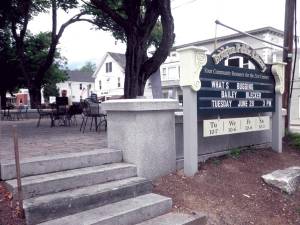The signs are inviting

AN INVITING SIGN — The finishing touch to the frontdoor courtyard project at Bridgton Library is this sign that went up recently, inviting the public to attend their events. Everything about the courtyard serves as an invitation to stop and tarry for awhile in downtown Bridgton. Patrons can enter through the front door once again, or, as Bill Gates of Rockville, Md. demonstrates, sit outside and surf the Web.
The signs are inviting in Bridgton this year. They speak of better times to come, of a time when we can look back and say 2011 was the year that Bridgton took charge of its own destiny.
Let’s start, literally in the heart of downtown, with the new sign that just went up in front of the Bridgton Public Library. Nothing timid about that big letterboard. Attractive and bold, facing drivers on Main Street, inviting people to slow down and come inside. Beside the sign is the new front courtyard with café-style tables and chairs, which also invites — whether for a place to access the free Wi-Fi, or just to sit and chat. It’s so inviting, in fact, that the local Taoist Tai Chi Society will gather regularly there to practice their ancient art.
What will convince people and their pocketbooks to come to Bridgton, in large enough numbers to sustain a year round economy? If buildings have personalities, this one has done a 360, going from sedate and conservative to trendy and extroverted. It is no longer “mooning the street.†By itself, a personality change at a public library doesn’t amount to much. But it’s a sign and a symbol of a change in consciousness, a realization that buildings reflect a community’s values and character. And when they turn their face to invite the world, we do, too.
That’s why what’s happening now with the work of the Comprehensive Planning Committee on form-based codes is so exciting. The 11 members are looking at the form of the buildings in town, and how they relate to each other and to the street and the public spaces people occupy. They know that to be inviting to shoppers, tourists, businesses and real estate investors, Bridgton must embrace its unique identity — and the buildings are a huge part of what makes it special and gives it a sense of place. It’s an authentic New England Village, and that makes it an extremely marketable commodity in our cookie-cutter world.
Form-based codes make room for all kinds of uses — even the international franchises some people so dread — by focusing on the function and feel of the built environment. They spell out in visual detail what we value as it now exists, and where we’re willing to allow for change, by color-coding streets as to type, defining build-to lines and building heights and percentage of windows to walls. On March 1, when residents rejected a ban on big box stores and fast food restaurants, we intuitively knew, but didn’t have a language for, what makes Bridgton special. Form-based codes gives us one.
The March 1 vote, many said, was the kick in the butt Bridgton needed to not leave its future to chance. But in truth, many positive signs preceded the vote: the expansion of Renys (an invaluable anchor store) the renovated Magic Lantern Theater, development of Pondicherry Park with its Bob Dunning Bridge, development of the BRAG recreational fields and creation of the Bridgton Economic Development Corporation. It’s worth anyone’s time, who cares about Bridgton, to read its 2005 comprehensive plan. Its authors knew that “In a sense, the town was saved from franchise, generic development by the activities in nearby towns,†and that, with long-range planning, “Bridgton can capitalize on its character and proximity to remarkable natural resources to be a unique commercial destination point.â€
We might have turned the corner toward a year-round economy by now, had the 2008 economic recession not set in. Now many say it’s as bad as it has ever been, with no end in sight. But that doesn’t mean we have to settle for less. What it does mean is that we have to be even bolder, and smarter, and embrace new ideas that initially don’t make sense — form-based codes being one great example.
We can choose to float along with our separate lives and accept “the background static of perpetual discontent,†or we can evolve and grow. It only takes a few brave souls at first — like people doing Tai Chi in a public courtyard — willing to stand for something greater, while also serving themselves. With each person who awakens, the momentum in the collective consciousness grows and it becomes easier for others.
When you watch the runners take off up Main Street on the 4 on the Fourth, feel the energy, look around. The signs are inviting.
— G.G.

